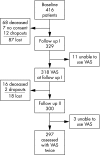Prevalence and intensity of pain after stroke: a population based study focusing on patients' perspectives
- PMID: 16354737
- PMCID: PMC2117435
- DOI: 10.1136/jnnp.2005.079145
Prevalence and intensity of pain after stroke: a population based study focusing on patients' perspectives
Abstract
Objective: To determine prevalence and intensity of pain after stroke, focusing on patients' perspectives.
Methods: During a one year period, 416 first-ever stroke patients were included in the population based Lund Stroke Register. After 4 and 16 months (median), 297 patients (98% of survivors) were followed up. Worst pain intensity during the previous 48 hours was assessed on a visual analogue scale (VAS), range 0 to 100: a score of 0 to 30 was defined as no or mild pain; 40 to 100 as moderate to severe pain. NIH stroke scale (NIHSS) score and HbA1c were assessed at baseline. At 16 months, screening for depression was done using the geriatric depression scale (GDS-20), and cognition with the mini-mental state examination (MMSE). Predictors of pain were determined by multivariate analyses.
Results: Moderate to severe pain was reported by 96 patients (32%) after four months (VAS median=60). Predictors of pain were younger age (p=0.01), female sex (p=0.006), higher NIHSS score (p<0.001), and raised HbA1c (p=0.001) at stroke onset. At 16 months, only 62 patients (21%) had moderate to severe pain, but pain intensity was more severe (median VAS score=70; p<0.016). Higher pain intensity correlated with female sex, worse GDS-20 score, better MMSE score, and raised HbA1c. Pain was persistent in 47%, disturbed sleep in 58%, and required rest for relief in 40% of patients.
Conclusions: Although prevalence of pain after stroke decreased with time, after 16 months 21% had moderate to severe pain. Late pain after stroke was on average more severe, and profoundly affected the patients' wellbeing.
Conflict of interest statement
Competing interests: none declared
Comment in
-
Pain after stroke: a neglected issue.J Neurol Neurosurg Psychiatry. 2006 May;77(5):569. doi: 10.1136/jnnp.2005.085761. J Neurol Neurosurg Psychiatry. 2006. PMID: 16614012 Free PMC article.
References
-
- McLean D E. Medical complications experienced by a cohort of stroke survivors during inpatient, tertiary‐level stroke rehabilitation. Arch Phys Med Rehabil 200485466–469. - PubMed
Publication types
MeSH terms
LinkOut - more resources
Full Text Sources
Medical


